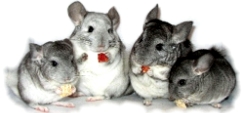
Hay and hay cubes need to be able to "breathe", but still be stored to keep any bugs out of it. Any moisture left in the hay, or that would get in the hay, could easily cause it to mold, especially if it is stored in air-tight containers. Mold gives off a 'musty' odor and will often show-up as a gray/blue/black powder. Take a good whiff of the hay/hay cubes before giving it to your chin, you should be able to smell any mold. Moldy hay can cause major problems!
If you buy hay in small bags and make sure you rotate the stock, that is the best way to assure it's freshness.
If you purchase large bags of hay cubes and/or large bales of hay, like I do, I find the free-standing (off the floor) cloth clothes hamper with a lid, keeps the hay fresh longer.

large rubbermaid bin without the top closed
A plastic bin may not allow the hay in the bottom to have enough fresh air. Leaving the top open leaves an open invitation to bugs.
Mesh bags have a tendance to allow all the fine particles of the hay to accumulate on the floor, where cloth (usually a light-weight canvas) keeps all the hay where it needs to be ... in the bag. If you can not find one with a lid, you might consider getting a light weight board to set on top of the clothes bin.
Always dispose of any uneaten hay after 24 hours that may be left on the cage floor. Replace it with fresh hay, daily. A chinchilla can urinate on the hay and cause it to mold, even after you have made sure it was not moldy when you gave it to him.

Jo Ann

 Author
Topic: Moldy Hay (Read 3026 times)
Author
Topic: Moldy Hay (Read 3026 times)




